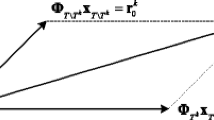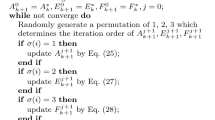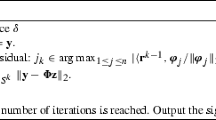Abstract
In this paper, a unified matrix recovery model was proposed for diverse corrupted matrices. Resulting from the separable structure of the proposed model, the convex optimization problem can be solved efficiently by adopting an inexact augmented Lagrange multiplier (IALM) method. Additionally, a random projection accelerated technique (IALM+RP) was adopted to improve the success rate. From the preliminary numerical comparisons, it was indicated that for the standard robust principal component analysis (PCA) problem, IALM+RP was at least two to six times faster than IALM with an insignificant reduction in accuracy; and for the outlier pursuit (OP) problem, IALM+RP was at least 6.9 times faster, even up to 8.3 times faster when the size of matrix was 2 000×2 000.
Similar content being viewed by others
References
Candès E J, Romberg J, Tao T. Robust uncertainty principles: Exact signal reconstruction from highly incomplete frequency information[J]. IEEE Transactions on Information Theory, 2006, 52(2): 489–509.
Zhang C J, Liu J, Tian Q et al. Image classification by nonnegative sparse coding, low-rank and sparse decomposition[C]. In: International Conference on Computer Vision and Pattern Recognition. Providence, USA, 2011.
Ji H, Huang S B, Shen Z W et al. Robust video restoration by joint sparse and low rank matrix approximation[J]. SIAM Journal on Imaging Sciences, 2011, 4(4): 1122–1142.
Eckart C, Young G. The approximation of one matrix by another of lower rank[J]. Psychometrika, 1936, 1(3): 211–218.
Jolliffe I T. Principal Component Analysis[M]. Springer-Verlag, New York, USA, 1986.
Wright J, Ganesh A, Rao S et al. Robust principal component analysis: Exact recovery of corrupted low-rank matrices via convex optimization[C]. In: Neural Information Processing Systems. Vancouver and Whistler, Canada, 2009.
Candès E J, Li X D, Ma Y et al. Robust principal component analysis?[J]. Journal of the ACM, 2011, 58(3): 1–37.
Ganesh A, Wright J, Li X D et al. Dense error correction for low-rank matrices via principal component pursuit[C]. In: IEEE International Symposium on Information Theory. Austin, USA, 2010.
Xu H, Caramanis C, Sanghavi S. Robust PCA via outlier pursuit[J]. IEEE Transactions on Information Theory, 2012, 58(5): 3047–3064.
Toh K C, Yun S W. An accelerated proximal gradient algorithm for nuclear norm regularized least squares problems[J]. Pacific Journal of Optimization, 2010, 6(3): 615–640.
Wright J, Ganesh A, Min K et al. Compressive principal component pursuit[C]. In: IEEE International Symposium on Information Theory. Cambridge, USA, 2012.
Waters A E, Sankaranarayanan A C, Baraniuk R G. SpaRCS: Recovering low-rank and sparse matrices from compressive measurements[C]. In: Neural Information Processing Systems (NIPS). Granada, Spain, 2011.
Ganesh A, Min K, Wright J et al. Principal component pursuit with reduced linear measurements[C]. In: IEEE International Symposium on Information Theory. Cambridge, USA, 2012.
Mu Y D, Dong J, Yuan X T et al. Accelerated low-rank visual recovery by random projection[C]. In: International Conference on Computer Vision and Pattern Recognition. Providence, USA, 2011.
Cai J F, Candès E J, Shen Z W. A singular value thresholding algorithm for matrix completion[J]. SIAM Journal on Optimization, 2010, 20(4): 1956–1982.
Fazel M. Matrix Rank Minimization with Applications[D]. Stanford University, 2002.
Candès E J, Recht B. Exact matrix completion via convex optimization[J]. Foundations of Computational Mathematics, 2009, 9(6): 717–772.
Lin Z C, Chen M M, Ma Y. The Augmented Lagrange Multiplier Method for Exact Recovery of Corrupted Lowrank Matrices[R]. UIUC Technical Report, UILU-ENG-09-2215, 2009.
Hestenes M R. Multiplier and gradient methods[J]. Journal of Optimization Theory and Applications, 1969, 4(5): 303–320.
Gabay D, Mercier B. A dual algorithm for the solution of nonlinear variational problems via finite-element approximation[J]. Computers and Mathematics with Applications, 1976, 2(1): 17–40.
Yuan X M, Yang J F. Low-rank and sparse matrix decomposition via alternating direction methods[J]. Pacific Journal of Optimization, 2013, 9(1): 167–180.
He B S, Yang H. Some convergence properties of a method of multipliers for linearly constrained monotone variational inequalities[J]. Operations Research Letters, 1998, 23(3–5): 151–161.
Kontogiorgis S, Meyer R R. A variable-penalty alternating directions method for convex optimization[J]. Mathematical Programming, 1998, 83(1–3): 29–53.
Goldfarb D, Ma S Q. Convergence of fixed point continuation algorithms for matrix rank minimization[J]. Foundations of Computational Mathematics, 2011, 11(2): 183–210.
Papadimitriou C H, Raghavan P, Tamaki H et al. Latent semantic indexing: A probabilistic analysis[J]. Journal of Computer and System Sciences, 2000, 61(2): 217–235.
Vempala S S. The Random Projection Method[M]. American Mathematical Society, USA, 2004.
Author information
Authors and Affiliations
Corresponding author
Additional information
Supported by National Natural Science Foundation of China (No.51275348) and College Students Innovation and Entrepreneurship Training Program of Tianjin University (No.201210056339).
Wang Ping, born in 1967, female, Dr, Prof.
Rights and permissions
About this article
Cite this article
Wang, P., Zhang, C., Cai, S. et al. Accelerated matrix recovery via random projection based on inexact augmented Lagrange multiplier method. Trans. Tianjin Univ. 19, 293–299 (2013). https://doi.org/10.1007/s12209-013-2135-0
Accepted:
Published:
Issue Date:
DOI: https://doi.org/10.1007/s12209-013-2135-0




